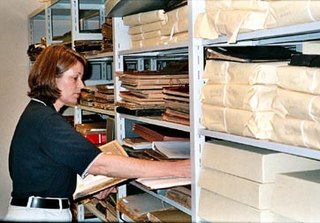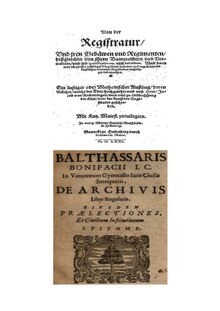
An archive is an accumulation of historical records or materials – in any medium – or the physical facility in which they are located.

Digitization is the process of converting information into a digital format. The result is the representation of an object, image, sound, document, or signal obtained by generating a series of numbers that describe a discrete set of points or samples. The result is called digital representation or, more specifically, a digital image, for the object, and digital form, for the signal. In modern practice, the digitized data is in the form of binary numbers, which facilitates processing by digital computers and other operations, but digitizing simply means "the conversion of analog source material into a numerical format"; the decimal or any other number system can be used instead.

An archivist is an information professional who assesses, collects, organizes, preserves, maintains control over, and provides access to records and archives determined to have long-term value. The records maintained by an archivist can consist of a variety of forms, including letters, diaries, logs, other personal documents, government documents, sound and/or picture recordings, digital files, or other physical objects.
In library and archival science, digital preservation is a formal endeavor to ensure that digital information of continuing value remains accessible and usable. It involves planning, resource allocation, and application of preservation methods and technologies, and it combines policies, strategies and actions to ensure access to reformatted and "born-digital" content, regardless of the challenges of media failure and technological change. The goal of digital preservation is the accurate rendering of authenticated content over time. The Association for Library Collections and Technical Services Preservation and Reformatting Section of the American Library Association, defined digital preservation as combination of "policies, strategies and actions that ensure access to digital content over time." According to the Harrod's Librarian Glossary, digital preservation is the method of keeping digital material alive so that they remain usable as technological advances render original hardware and software specification obsolete.
In archival science, a fonds is a group of documents that share the same origin and that have occurred naturally as an outgrowth of the daily workings of an agency, individual, or organization. An example of a fonds could be the writings of a poet that were never published or the records of an institution during a specific period.
Encoded Archival Description (EAD) is a standard for encoding descriptive information regarding archival records.

The following outline is provided as an overview of and topical guide to library and information science:
A finding aid, in the context of archival science, is an organization tool, a document containing detailed, indexed, and processed metadata and other information about a specific collection of records within an archive. Finding aids often consist of a documentary inventory and description of the materials, their source, and their structure. The finding aid for a fonds is usually compiled by the collection's entity of origin, provenance, or by an archivist during archival processing, and may be considered the archival science equivalent of a library catalog or a museum collection catalog. The finding aid serves the purpose of locating specific information within the collection. The finding aid can also help the archival repository manage their materials and resources. The history of finding aids mirrors the history of information. Ancient Sumerians had their own systems of indexes to locate bureaucratic and administrative records. Finding aids in the 19th and 20th centuries were paper documents, such as lists or index cards. In the 21st century, they can be created in electronic formats like spreadsheets or databases. The standard machine-readable format for manuscript collection finding aids, widely used in the United States, Canada, the United Kingdom, France, Australia and elsewhere, is Encoded Archival Description.
Language documentation is a subfield of linguistics which aims to describe the grammar and use of human languages. It aims to provide a comprehensive record of the linguistic practices characteristic of a given speech community. Language documentation seeks to create as thorough a record as possible of the speech community for both posterity and language revitalization. This record can be public or private depending on the needs of the community and the purpose of the documentation. In practice, language documentation can range from solo linguistic anthropological fieldwork to the creation of vast online archives that contain dozens of different languages, such as FirstVoices or OLAC.
Archival processing is the act of surveying, arranging, describing, and performing basic preservation activities on the recorded material of an individual, family, or organization after they are permanently transferred to an archive. A person engaging in this activity is known as an archival processor, archival technician, or archivist.

In conservation, library and archival science, preservation is a set of preventive conservation activities aimed at prolonging the life of a record, book, or object while making as few changes as possible. Preservation activities vary widely and may include monitoring the condition of items, maintaining the temperature and humidity in collection storage areas, writing a plan in case of emergencies, digitizing items, writing relevant metadata, and increasing accessibility. Preservation, in this definition, is practiced in a library or an archive by a conservator, librarian, archivist, or other professional when they perceive a collection or record is in need of maintenance.
Oral history preservation is the field that deals with the care and upkeep of oral history materials, whatever format they may be in. Oral history is a method of historical documentation, using interviews with living survivors of the time being investigated. Oral history often touches on topics scarcely touched on by written documents, and by doing so, fills in the gaps of records that make up early historical documents.
In archival science and archive administration, appraisal is a process usually conducted by members of the record-holding institution in which a body of records is examined to determine its value for that institution. It also involves determining how long this value will last. The activity is one of the central tasks of an archivist, to determine the archival value of specific records. When it occurs prior to acquisition, the appraisal process involves assessing records for inclusion in the archives. In connection with an institution's collecting policy, appraisal "represents a doorway into the archives through which all records must pass". Some considerations when conducting appraisal include how to meet the record-granting body's organizational needs, how to uphold requirements of organizational accountability, and how to meet the expectations of the record-using community.
Preservation metadata is item level information that describes the context and structure of a digital object. It provides background details pertaining to a digital object's provenance, authenticity, and environment. Preservation metadata, is a specific type of metadata that works to maintain a digital object's viability while ensuring continued access by providing contextual information, usage details, and rights.

Archival research is a type of research which involves seeking out and extracting evidence from archival records. These records may be held either in collecting institutions, such as libraries and museums, or in the custody of the organization that originally generated or accumulated them, or in that of a successor body. Archival research can be contrasted with (1) secondary research, which involves identifying and consulting secondary sources relating to the topic of enquiry; and (2) with other types of primary research and empirical investigation such as fieldwork and experiment.
Howard Besser is a scholar of digital preservation, digital libraries, and preservation of film and video. He is Professor of Cinema Studies and the founding director of the NYU Moving Image Archiving and Preservation Program ("MIAP"), a graduate program in the Tisch School. Besser also worked as a Senior Scientist at New York University's Digital Library Initiative. He conducted extensive research in image databases, multimedia operation, digital library, and social and cultural influence of the latest Information Technology. Besser is a prolific writer and speaker, and has consulted with many governments, educational institutions, and arts agencies on digital preservation matters. Besser researched libraries' new technology, archives, and museums. Besser has been actively contributing at the international level to build metadata and upgrade the quality of the cultural heritage community. He predominantly, focused on image and multimedia databases; digital library aspects ; cultural and societal impacts of information technology, and developing new teaching methods through technology such as web-based instructions and distance learning. Besser was closely involved in development of the Dublin Core and the Metadata Encoding and Transmission Standard (METS), international standards within librarianship.
Respect des fonds, or le respect pour les fonds, is a principle in archival theory that proposes to group collections of archival records according to their fonds. It is one of several principles stemming from provenance that have guided archival arrangement and description from the late 19th century until the present day. It is similar to archival integrity, which dictates that "a body of records resulting from the same activity must be preserved as a group." It is also closely related to the idea of original order – the idea that archivists ought to maintain records using the creator's organizational system. However, respect des fonds differs from that other foundational sub-principle of provenance in its concern with the integrity of the collection or record group as a whole rather than the organization of materials within that collection or record group.
Original order is a concept in archival theory that a group of records should be maintained in the same order as they were placed by the record's creator. Along with provenance, original order is a core tenet of the archival concept of respect des fonds. A primary goal of keeping records in their original order is to preserve additional contextual information about the records' creator and the environment of their creation. Original order also encourages the archivist to remain neutral as opposed to applying any interpretation to the records.
"More Product, Less Process: Revamping Traditional Archival Processing" is a 2005 archival science article written by Mark A. Greene and Dennis Meissner that first appeared in the Fall/Winter 2005 issue of The American Archivist. The paper argues that traditional archival processing is too slow, and advocates for the use of minimal processing in order to reduce backlogs and provide access to archival collections as quickly as possible. The ideology presented in the article, abbreviated as MPLP, has since been widely adopted in modern archival theory with subsequent praise directed primarily towards the ability to increase user accessibility without prohibiting the option for future processing.

In archives, the term "audiovisual" is frequently used generically to denote materials other than written documents. Films, videos, audio recordings, pictures, and other audio and visual media are collected in audiovisual archives. A vast amount of knowledge is included in audiovisual records, which are considered cultural treasures and must be preserved for future use. Print materials would not have the same reach across various audiences as audiovisual resources.










